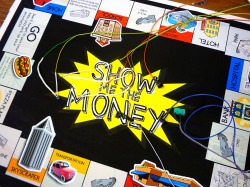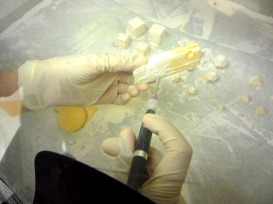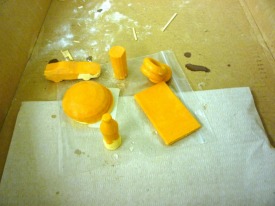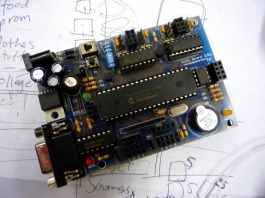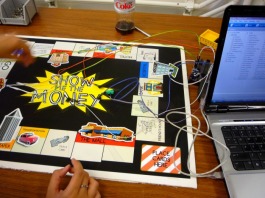The Board Game
Designing the board game
We designed a board game on financial literacy for youth. We used sensors and artifacts embedded in our game to enhance our user's experience of the game. We hope to develop a deeper understanding about financial decisions in their daily and future life, as well as provide opportunities to practice skills such as budgeting and saving. This is done by having participants go through specific challenges and tasks where they will have to make financial decisions and manage their money.
We envisioned creating a lot of items with many pieces such as game pieces, artifacts (i.e., small items that players can purchase). We are used SketchUp to draw these pieces and to create them using either the 3D printer or the laser cutter. We also used the 3D printer for items that are going to be "purchased" since these should look cool enough for the players to want to buy them. We are thinking of integrating sensors into the board game. For this, we would probably need the GoGo boards and NetLogo. We think that incorporating sensors into the board game will help make the game more engaging for kids.
We envisioned creating a lot of items with many pieces such as game pieces, artifacts (i.e., small items that players can purchase). We are used SketchUp to draw these pieces and to create them using either the 3D printer or the laser cutter. We also used the 3D printer for items that are going to be "purchased" since these should look cool enough for the players to want to buy them. We are thinking of integrating sensors into the board game. For this, we would probably need the GoGo boards and NetLogo. We think that incorporating sensors into the board game will help make the game more engaging for kids.
We decided that a board game with 3D artifacts and sensors would be a good option for teaching financial concepts to kids for the following reasons:
- Ability to create tangible artifacts that the users could place more value on. For example, having money that the users could hold, or items like a car, food, that the users can keep after purchase, as opposed to just having a picture of an item on the screen
- To facilitate social interaction. First, we thought it would be easier to create the social interaction using a boardgame versus having to create an online application where users could play remotely. Second, based on some papers we have read, peers were identified as one of the important influences for a teen's decision making. We wanted to have the teen interact in real time (and real life!) with their peers so they could bounce off questions, comments, as well as see how their fellow teens decided on the scenarios
- To be able to quickly get a sense of their assets by simply looking at the board and the items that they have on hand. (An online simulation would limit one to the size of the computer screen.)
- To use sensors to trigger random events that occur in real life. Although we have incorporated some surprise and emergency events in the game by use of cards, we think that the sensors and output are a good way to simulate certain random events that occur in real life
Learning goals
These are the things we hope that can be learned with the board game activities and what we expect students can do after engaging in them:
Budgeting. The players will be given money to use throughout this game. They will also be given budget sheets where they need to track down their income and expenses. They will need to purchase items based on the challenges that they encounter. Hopefully, via this activity they will be able to learn and practice how to budget their money properly so they are able to purchase the necessary items and visualize how their financial decisions sum up over time.
Banking, interest rates. We will to introduce the concept of banking and interest rates to the players. They are able to deposit money where their money can earn interest, they also can borrow money from the bank as well. This will give players a better idea of how banks and interest rates work.
Credit scores. We are introducing the concept of credit cards in the game. Players have the option to apply for a credit card with which they can buy products. However, it is also subject to the same rules as regular credit cards. Through this activity, we hope the players become more aware of what the consequences of using a credit card is (monthly payments, etc.) We are also introducing credit scores so that they are aware that their actions could potentially affect them in a much larger way in the future.
Decision making. The game does not proceed in a linear fashion. There are several forks in the game where users will have to make decisions. There are also "surprise" circumstances that players will have to deal with. By laying out these decisions and consequences in a way that is readily visible to the players, we hope this will improve their financial decision making and overall financial strategies.
Trade offs. In our game we show how making certain decisions (ex. purchasing certain items, depositing money) affects other, future decisions. For example, if they purchase a bike, they get to save money versus if they take the bus or train all the time. However, they will have to shell out money for the initial purchase. Or, if they choose to deposit their money, they will get money back but then they will not have any cash on hand.
Money visualization. Through our game, we hope players will be able to better visualize the flow of money throughout their lives. For example, they can see what options they have with regards to managing their money (banks, credit cards, etc.) and at the same time they can see where they spend money on.
Deadline. The game requires players to make decision and has certain criteria to develop deadline as a way to make the playing more challenging
Debt: We also show during the game that player can get into debt, usually with a high IR, so they can visualize the problematic issues around borrowing money or overspending your credit card.
Budgeting. The players will be given money to use throughout this game. They will also be given budget sheets where they need to track down their income and expenses. They will need to purchase items based on the challenges that they encounter. Hopefully, via this activity they will be able to learn and practice how to budget their money properly so they are able to purchase the necessary items and visualize how their financial decisions sum up over time.
Banking, interest rates. We will to introduce the concept of banking and interest rates to the players. They are able to deposit money where their money can earn interest, they also can borrow money from the bank as well. This will give players a better idea of how banks and interest rates work.
Credit scores. We are introducing the concept of credit cards in the game. Players have the option to apply for a credit card with which they can buy products. However, it is also subject to the same rules as regular credit cards. Through this activity, we hope the players become more aware of what the consequences of using a credit card is (monthly payments, etc.) We are also introducing credit scores so that they are aware that their actions could potentially affect them in a much larger way in the future.
Decision making. The game does not proceed in a linear fashion. There are several forks in the game where users will have to make decisions. There are also "surprise" circumstances that players will have to deal with. By laying out these decisions and consequences in a way that is readily visible to the players, we hope this will improve their financial decision making and overall financial strategies.
Trade offs. In our game we show how making certain decisions (ex. purchasing certain items, depositing money) affects other, future decisions. For example, if they purchase a bike, they get to save money versus if they take the bus or train all the time. However, they will have to shell out money for the initial purchase. Or, if they choose to deposit their money, they will get money back but then they will not have any cash on hand.
Money visualization. Through our game, we hope players will be able to better visualize the flow of money throughout their lives. For example, they can see what options they have with regards to managing their money (banks, credit cards, etc.) and at the same time they can see where they spend money on.
Deadline. The game requires players to make decision and has certain criteria to develop deadline as a way to make the playing more challenging
Debt: We also show during the game that player can get into debt, usually with a high IR, so they can visualize the problematic issues around borrowing money or overspending your credit card.
How to play the board game
The idea of the board game is that upon completing the simulation, kids would then be able play this board game with their friends. The board game starts out with a budgeting sheet that requires kids to fill out first. Kids are then allotted a certain amount of money at the start of the game based on their set income. Each loop of the board game represents one week in the life of a high schooler. As kids go around the loop, they have to make decisions about what they want to do at each location they land on (i.e., the mall, the pizza place, hospital, etc.) If they decide to purchase something, their expenses are recorded on their budget sheet and each transaction is recorded. The objective of the game is to see who has both the highest difference between their budget and the amount they spent over a period of two weeks while achieving a certain level of happiness.
The budget sheet for the game can be downloaded here:
The budget sheet for the game can be downloaded here:
| budget_sheet.doc |
